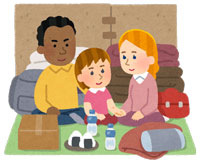2021.05.28

Typhoons (taifū / 台風), localized torrential rain (shūchū gōu / 集中豪雨) and tornadoes (tatsumaki / 竜巻) are examples of meteorological phenomena that often occur at this time of year that can cause storm and flood-related disasters (fūsuigai / 風水害).
Don't wait until a typhoon approaches, heavy rain begins to fall, or you are told to evacuate, to prepare. There are steps you can take in your everyday life to help yourself to be prepared if an emergency situation arises, such as picking up something you might need in an emergency when you go shopping. Resources such as flood, internal inundation and storm surge hazard maps are available to help you find out the risks beforehand and prepare accordingly.
Types of storm and flood-related disasters
 Flooding (suigai / 水害)
Flooding (suigai / 水害)
- Floods (kōzui / 洪水) / external inundation (gaisui hanran / 外水氾濫):
Flooding of residential areas, etc. caused by the bursting of a river bank, or a river overflowing due to heavy rain.
- Internal inundation (naisui hanran / 内水氾濫):
Flooding which occurs when drains and sewers are not able to cope with the sudden large volume of water generated by localized heavy rain.
Storm surge (takashio / 高潮):
An extreme rise in the sea level as a typhoon approaches. The low air pressure of the typhoon draws the sea upwards, while the strong winds drive the water to surge forward.
Landslide / sediment-related disasters (dosha saigai / 土砂災害):
Includes debris flows (dosekiryū / 土石流, a flow of mud, rock, sand, soil and water from mountains and rivers), landslides (jisuberi / 地すべり) and slope failures (gake kuzure / がけ崩れ).
Help yourself to be prepared
 Things to do day to day
Things to do day to day
- Keep stormwater drains and inlets clean
- Remove or put away anything around your house that could be blown away
- Keep your valuables and important documents upstairs
- Confirm the location of designated emergency assembly points and designated evacuation shelters, and the route you will take to get there.
- Familiarize yourself with the inundation risk around the area where you live and work with the flood hazard map
Flood hazard maps
 Areas at risk of flooding due to heavy rain, etc. are indicated in the Flood Hazard Map (洪水・内水ハザードマップ) for each ward, issued by the City of Nagoya.
Areas at risk of flooding due to heavy rain, etc. are indicated in the Flood Hazard Map (洪水・内水ハザードマップ) for each ward, issued by the City of Nagoya.
Use the maps to check the flood risk for the area around your home, and think about where to evacuate if the need arises. Maps are in Japanese, but if you can read a map and find your place of residence, work, etc., you can refer to the color key diagram to see the projected depth for that location, compared to the height of a car, a house, and a multi-storey building.
Maps contain projections for a number of scenarios, for example if a river were to burst its banks, or if torrential rain were to cause internal inundation.
For tips on how to read the hazard maps, and links to the maps, see here.
Get information
Establish how you will obtain information in a disaster, e.g. via TV or radio, through the emergency speaker system, from the website, e-mail notification service or SNS of the Japan Meteorological Agency or your local government
Help one another
Value day-to-day interaction with your neighbors, and help one another when an emergency occurs
Keep a store of items you might need
Check these items regularly (e.g. food is not out of date, radio and torch batteries work)
★Evacuation kit checklist
 Prepare and regularly check these items to be ready to evacuate at any time.
Prepare and regularly check these items to be ready to evacuate at any time.
Items to have prepared in case of emergency
□Plastic container, bucket for water
□Rope
□Crowbar
□Saw, other tools
Useful items
□Dry shampoo
Bedding, etc.
□Blankets
□Sleeping bag
□Camping tent
Fuel
□Portable gas stove (with spare gas cartridges)
□Solid fuel
 Essential items for survival
Essential items for survival
□Food with a long shelf life (and also easy to eat)
□Household medicines (also medicine currently taken for existing conditions)
□Drinking water (in plastic bottles)
3 liters per person per day. In combination with foods with a high water content (e.g. jelly), water can be reduced.
Stock should be sufficient for 7 days; Have 3 days' worth in your emergency evacuation kit.
★Items for your emergency evacuation kit
(to take with you when evacuating)
| □Portable radio | Items to prevent infection |
| □Helmet, protective hood | □Alcohol-based sanitizer |
| □Working gloves | □Slippers |
| Valuables | □Thermometer |
| □Cash (also coins) | □Masks |
| □Copy of bankbook | □Garbage bags |
| □Copy of health insurance card, driver's license | Useful items |
| □Credit cards | □Pens |
| □Personal seals, etc. | □Newspaper |
| Tableware | □Portable toilet |
| □Chopsticks, spoons | □Kitchen wrap |
| □Paper plates, paper cups | □Disposable heater packs |
| □Drink bottle | □Rain wear |
| Lighting, etc. | □Manual mobile phone charger |
| □Torch (also batteries) | □Toilet paper |
| □Matches, lighter | Other |
| Medical supplies | □Milk (powdered / liquid) |
| □Triangular bandage | □Disposable diapers |
| □Bandages, gauze | □Sanitary napkins |
| □Adhesive plaster | □Spare glasses, hearing aid, etc. |
| □Disinfectant | □Pet necessities (food, water, etc.) |
| □Wet wipes (tissues) | |
| □Medicine history handbook | |
| Clothing, etc. | |
| □Clothes (change of clothes) | |
| □Towels (large and small) |
 Keep an eye on the weather - Japan Meteorological Agency Website
Keep an eye on the weather - Japan Meteorological Agency Website
The JMA website (https://www.jma.go.jp/jma/indexe.html) is a great resource for keeping an eye on typhoons and related risks, with a multilingual interface.
- Tropical Cyclone (Typhoon) Information
- Real-time Risk Maps for precipitation and landslides, inundation, flooding
- Current Warnings / Advisories
Evacuation Information
*Revised Evacuation Information came into effect on 20 May, 2021.
Evacuation Information (hinan jōhō / 避難情報) is issued by the City of Nagoya if flooding (external inundation), internal inundation, landslide, etc. are predicted. There are 5 Alert Levels (keikai reberu / 警戒レベル) to clarify the corresponding measures to be taken by residents.
See here for more information.
When Evacuation Information is issued by the City of Nagoya, Nagoya International Center will publish the same information on the NIC website and on Facebook in Easy Japanese, English, Portuguese, Spanish, Chinese, Korean, Filipino, Vietnamese and Nepali.
See here for more information.
When evacuating
 Rubber boots will fill with water and make it difficult to walk. Avoid going barefoot. Wear lace-up sneakers.
Rubber boots will fill with water and make it difficult to walk. Avoid going barefoot. Wear lace-up sneakers.- The person leading the group should carry a long stick to prod the ground ahead and detect unseen ditches or drains.
- Evacuation can become dangerous if the inundation depth exceeds 50cm; don't take the risk - take refuge in a safe building nearby.
- Carry your evacuation kit and other belongings in a backpack. Keep your hands free.
- When evacuating, follow the directions of ward staff, fire department staff and police. Don't act in response to rumors. Get information from radio, TV, loudspeaker vehicles and other official sources.
- Don't try to evacuate by car or bicycle.
- Check on neighbors before evacuating, and try to help one another. People who are ill or unable to walk should be carried piggyback.
 Taking shelter at home
Taking shelter at home
Evacuation shelters, with their tendency to become closed, crowded spaces with poor ventilation, and evacuees being in close contact with one another, have the potential to become hygiene hazards.
Check the hazard map and see if it will be safe enough to take shelter at home (zaitaku hinan / 在宅避難). If you can still live in your home after the disaster subsides, you can shelter at home and register as an evacuee at an evacuation shelter to receive food and other supplies at the shelter.
Measures to prevent the spread of infectious disease at evacuation shelters
 The following measures will be implemented at evacuation shelters to prevent the spread of infectious diseases. When taking refuge at a shelter, please wear a mask and keep your distance from others at reception.
The following measures will be implemented at evacuation shelters to prevent the spread of infectious diseases. When taking refuge at a shelter, please wear a mask and keep your distance from others at reception.
- Body temperature and health checks will be conducted at reception to quickly assess if any evacuees are ill.
- Zoning will be implemented to prevent contact between any ill evacuees and other people. An area will be secured for ill evacuees to shelter.
- The following measures will be implemented to prevent the spread of infectious diseases within the evacuation area:
- Maintaining a safe distance between evacuees
- Routine cleaning and disinfecting of facilities
- Ventilation
- Thorough washing and disinfecting of hands, etc.




